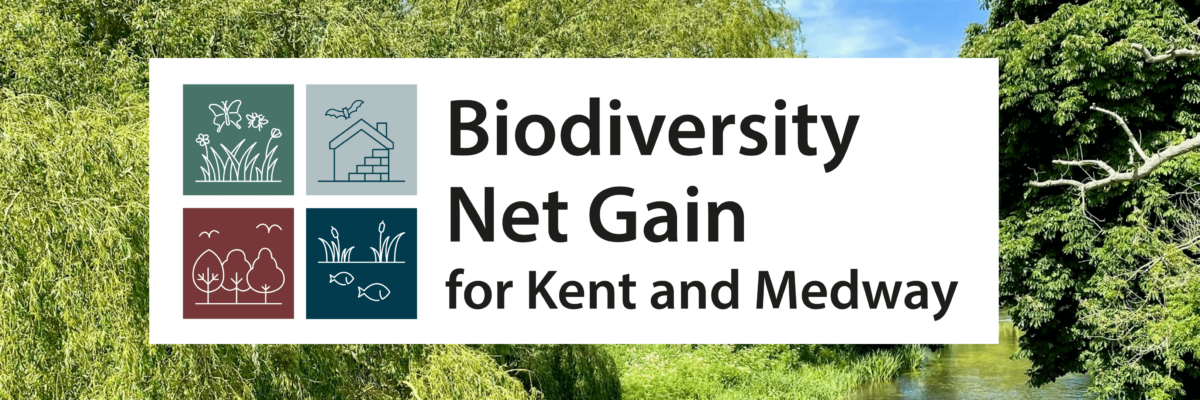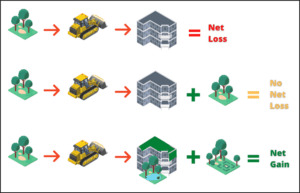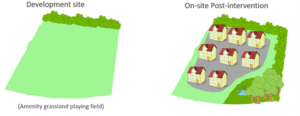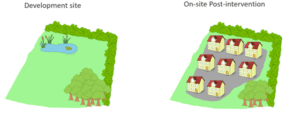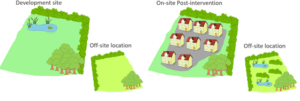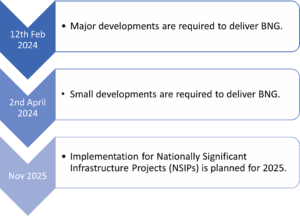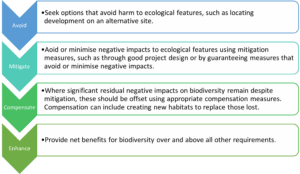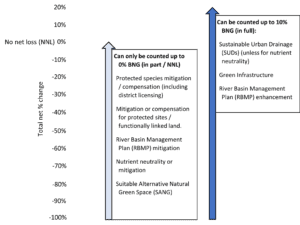Biodiversity Net Gain Guidance
This guidance has been developed by Kent County Council to provide applicants with consistent advice across Kent and Medway. Please use the drop down menu below to expand guidance on each topic relating to Biodiversity Net Gain.
Local Planning Authorities may develop individual approaches to Biodiversity Net Gain which will be set through local planning policy and guidance notes. It is therefore recommended that you confirm any local requirements with the relevant planning authority at the beginning of scheme design.
Some of the guidance included on this page has been developed by summarising national level guidance and more detail on these issues can be find via the links to national guidance.
For other issues, such as defining strategic significance categories and ‘significant on-site gains’ an approach for Kent and Medway has been developed.
This guidance page will continue to be updated. Please contact nicky.britton-williams@kent.gov.uk if you have any queries regarding the guidance on this page or to request additional guidance.
Introduction to Biodiversity Net Gain:
- What is Biodiversity Net Gain?

Biodiversity Net Gain (BNG) is an approach to development, and/or land management, that aims to leave the natural environment in a measurably better state than it was beforehand. It uses a Metric based approach to predict the net change in biodiversity value that will occur as a result of development or a change in land use.
- How is BNG measured?
BNG habitats are used as a “proxy for biodiversity”. In practice this means that habitats present within the developments red line boundary are assigned a score (termed “Biodiversity Unit” according on their importance for biodiversity. The developer then calculates how many Biodiversity Units will be generated post-development, accounting for both losses of habitat to the development footprint and habitats created enhanced through the landscaping strategy.
The method of calculating the number of Biodiversity Units for each habitat type has been set by DEFRA and is clearly defined through the Statutory Biodiversity Metric.
- How can BNG be achieved by development?
Some developments will be able to achieve the required uplift in BNG within the red line boundary (Figure 2). These developments are described as delivering all of their BNG “on-site”.

Figure 2: A simplified illustration of how a development could achieve a net gain in biodiversity using only habitat creation and enhancement within the development site.
Due to other constraints developments may not be able to achieve the required uplift in BNG within the red line boundary (Figure 3) and are therefore required to create or enhance habitat “off-site” (Figure 4).

Figure 3. A simplified illustration of a development which has resulted in a net loss of biodiversity within the development site. This could be due to other constraints on the development site.

Figure 4. The same simplified illustration of a development as in Figure 3, but with the addition of habitat creation a habitat creation and enhancement being delivered at an “off-site location”.
Where it can be demonstrated that is not possible to achieve the required uplift in biodiversity through habitat creation through either on-site or off-site BNG then developers may purchase “Statutory Biodiversity Credits”. These credits can be purchased from the government, with revenue from their sales being used for habitat creation and enhancement schemes across the UK (not necessarily in Kent).
- From when do developments need to deliver BNG?
The commencement order sets out that the provisions of the Environment Act (2021) come into force on 12th February 2024. This means that from this date major developments (that do not meet the exemption criteria) must deliver BNG. There is a temporary exclusion for small developments until 2nd April 2024. Implementation for Nationally Significant Infrastructure Projects (NSIPs) is planned for 2025.
It is important to note that the mandatory BNG requirement applies to applications submitted on these dates, not validated.

- What exemptions apply for BNG?
Not every major and small development will be required to deliver BNG. A set of exemption are set out by regulations.
Exemptions as set out in The Biodiversity Gain Requirements (Exemptions) Regulations 2024
- Temporary exemption for small developments until 2nd April 2024.
- The biodiversity gain planning condition does not apply in relation to a section 73 planning permission where the original planning permission was exempt (e.g. original planning permission was submitted prior to 12th February 2024).
- De minimis exemption:
- No impact on priority habitat
- Development impacts less than 25 square metres of onsite habitat, with a biodiversity metric value greater than zero.
- Less than 5m of linear habitat on site.
- Householder applications
- High Speed Railway Transport Network
- Planning permission required to deliver a consented BNG scheme.
- Self-build and custom build applications (where there are no more than 9 dwellings, on a site no larger than 0.5ha, consists exclusively of self-build or custom housebuilding).
- What is a 'major development'?
‘Major Development’ is defined as per as defined in article 2(1) of the Town and Country Planning (Development Management Procedure) (England) Order 2015.
“Major development” means development involving any one or more of the following:
(a) the winning and working of minerals or the use of land for mineral-working deposits;
(b) waste development;
(c) the provision of dwellinghouses where—
-
- the number of dwellinghouses to be provided is 10 or more; or
- the development is to be carried out on a site having an area of 0.5 hectares or more and it is not known whether the development falls within sub-paragraph (c)(i);
(d) the provision of a building or buildings where the floor space to be created by the development is 1,000 square metres or more; or
(e) development carried out on a site having an area of 1 hectare or more
-
- What is a 'small development'?
‘Small developments’ are those that do not fall into the category of a major development above.
Small developments include the following:
- residential development where the number of dwellings is between 1 and 9, or if this is unknown, the site area is less than 0.5 hectares
- commercial development where floor space created is less than 1,000 square metres or total site area is less than 1 hectare
- development that is not the winning and working of minerals or the use of land for mineral-working deposits
- development that is not waste development
- Who can calculate BNG?
The User Guide for the Statutory Biodiversity Metric sets out that the BNG assessment must be undertaken by a ‘competent person’. A competent person is described as someone who “has the knowledge and skills to perform specified tasks to complete and review biodiversity metric calculations. You obtain this through training, qualifications, experience, or a combination of them.” The definition of competency in BNG is aligned with the British Standard ‘Process for designing and implementing biodiversity net gain (BS 8683:202)’. There is an additional requirement for river assessments.
- How is BNG applied to different types of planning application?
BNG should be calculated for both Outline and Full applications. BNG calculations shall also be resubmitted for any reserved matters application or material amendment that is likely to affect BNG.
Outline and phased applications will require additional biodiversity gain information that sets out how biodiversity gain will be achieved across the whole site on a phase-by-phase basis will be required for outline planning permissions and phased development. These applications will also be subject to a condition that requires a BNG Plan prior to commencement of each phase.
Reserved matters will not be required to fulfil mandatory BNG if the outline was approved prior to mandatory BNG; it will only apply to new applications submitted after BNG is mandated (from 12th February 2024).
General Principles of Mandatory Biodiversity Net Gain:
- What is the Mitigation Heirarchy?
Principle 2 of the Statutory Biodiversity Metric User Guide sets out the use of the biodiversity metric “does not override existing protections, statutory obligations, policy requirements, ecological mitigation hierarchy or any other requirements.”
Paragraph 186 of the NPPF (2023) sets out the need to apply the mitigation hierarchy when determining planning application; (underlining our own)
“if significant harm to biodiversity resulting from a development cannot be avoided (through locating on an alternative site with less harmful impacts), adequately mitigated, or, as a last resort, compensated for, then planning permission should be refused.”
The sequential mitigation hierarchy is central to delivering BNG. Applicants should demonstrate how the mitigation hierarchy has been applied through their ecological reports submitted in support of their application.

- Onsite vs Offsite vs National Biodiversity Credit Scheme
In addition to the mitigation hierarchy, legislation and policy sets out a sequential hierarchy of BNG delivery, which prioritising on-site BNG unit delivery, then off-site BNG unit delivery, and then the purchasing of statutory credits as a last resort (Figure 7).
This hierarchy is further supported and incentivised through the spatial risk multiplier which dis-incentivises delivery of BNG further from the development site. In addition, the government has set statutory credit system at a price that is deemed likely to be significantly higher that the sale of local biodiversity units.
NOTE: There is a distinction between the use of the term ‘units’ and ‘credits’, with ‘credits’ only being used in the context of purchasing Statutory Credits.

- Biodiversity Gain Hierarchy
The Biodiversity Gain Hierarchy effectively combines the mitigation hierarchy with the BNG delivery hierarchy above.
The Biodiversity net gain planning practice guidance sets out the Biodiversity Gain Hierarchy, which planning authorities must take account of when determining the Biodiversity Gain Plan (underlining our own):
“The biodiversity gain hierarchy means the following actions in the following order of priority:
- avoiding adverse effects of the development on onsite habitat with a habitat distinctiveness score, applied in the biodiversity metric, equal to or higher than six;
- so far as those adverse effects cannot be avoided, mitigating those effects;
- so far as those adverse effects cannot be mitigated, habitat enhancement of onsite habitat;
- so far as there cannot be that enhancement, creation of onsite habitat;
- so far as there cannot be that creation, the availability of registered offsite biodiversity gain;
- so far as that offsite habitat enhancement cannot be secured, purchasing biodiversity credits.
Developers are encouraged to follow the Biodiversity Gain Hierarchy from the earliest stage possible when selecting a site and considering development proposals.”
Applicants should demonstrate how they have applied the Biodiversity Gain Hierarchy, providing reasoned justification as to why their scheme required off-site units and/or statutory credits as a last resort.
- Irreplaceable habitats
Irreplaceable habitats are afforded significant protection in the National Planning Policy Framework, which will not be affected by the introduction of mandatory BNG. The is a presumption in favour of refusal of development that results in the loss or deterioration of irreplaceable habitats, unless “wholly exceptional reasons and a suitable compensation strategy” exist.
Because these habitats cannot be recreated the mandatory BNG requirement is not applied to irreplaceable habitats. The presence of irreplaceable habitats must still be recorded in the biodiversity metric, as per the Statutory Biodiversity Metric User Guide. Bespoke compensation for loss or degradation of irreplaceable habitats must be agreed with the planning authority.
It is possible to include enhancements of irreplaceable habitats within a developments BNG requirement.
The Biodiversity Gain Requirements (Irreplaceable Habitat) Regulations 2024 defines irreplaceable habitats as:
- Ancient woodland
- Ancient and veteran trees
- Blanket bog
- Limestone pavements
- Coastal sand dunes
- Spartina saltmarsh swards
- Mediterranean saltmarsh scrub
- Lowland fens
- What can count towards BNG? (Additionality)
Defra have provided guidance on what you can count towards a development’s biodiversity net gain.
There has previously been some ambiguity within the published guidance, advice provided through national webinars and direct correspondence with Natural England and Defra. This may have resulted in a varying understanding on how the principle of additionality should be applied. Following the updating of Defra’s guidance on the 12th February, read alongside advice from Natural England, the only accepted application of the principle of additionality is as set out below.
The term ‘No Net Loss’ is used when referring to habitat creation or enhancement which achieves a biodiversity value equal to the pre-development baseline (0% BNG). A net gain in biodiversity is achieved through additional habitat creation or enhancement to achieve 10% BNG (or a higher percentage of specified by local policy). In some instances it will be important for applicants to specify which habitat has been used to deliver the 10% net gain in biodiversity.
BNG does not replace or supersede any other environmental protections and regulations. Habitat creation or enhancement can only be counted towards achieving a net gain in biodiversity if it is additional to that required to fulfil any other form of statutory obligation. In other words, BNG must be ‘above business as usual’ and must be genuinely additive.
In practice, this would mean that habitat creation and enhancement that would have been required regardless of BNG (e.g. protected species mitigation) could be included up to a point of no net loss (0% BNG), with the BNG target being achieved via additional habitat creation and enhancement.
Defra’s guidance provides clear examples of what can be counted to an applicants full BNG percentage (up to 10% BNG) vs what can only be included in part (up to no net loss – 0% BNG).
Additionality requirements apply equally to on and offsite BNG.

- How to demonstrate additionality
Use two separate metrics. Metric 1 to demonstrate the post-development scenario for any habitat provided to mitigate/compensate for impacts on protected sites and species, and Metric 2 to demonstrate how the minimum of 10% BNG will be delivered i.e. beyond that shown in Metric 1.
Note: Metric 1 could potentially show a positive change in biodiversity units, but as explained in Q1. above, this cannot count towards 0-10% even if surplus units are created.
Note: NE are discussing this item with Defra and some example case studies of how to do this will be published once the statutory metric goes live, but until this point it is the LPAs discretion as to how they might want to see this presented as part of an application.
- Trading Rules
In short, the trading rules require that habitat creation or enhancement is of a distinctiveness level that is either of the same quality of that being lost, or of a higher quality.
Refer to the Statutory Biodiversity Metric User Guide for full details.
- Strategic Signifiance
The Interim Strategic Significance Guidance for Biodiversity Net Gain in Kent and Medway has been produced by Kent County Council (KCC), under consultation with the Kent Nature Partnership (KNP). This biodiversity guidance note has been developed to help planning applicants and potential Biodiversity Net Gain (BNG) offset providers complete the strategic significance elements of The Biodiversity Metric for area habitats and linear habitats (hedgerows and watercourses).
Applicants should refer to how they have applied this guidance within their Biodiversity Gain Statement (and/or Plan) and supporting documents.
This interim guidance will be reviewed periodically and will eventually be replaced by a published Local Nature Recovery Strategy for Kent and Medway (expected publication date spring/summer 2025).
- Definition of 'Significant Onsite Enhancements'
Defra’s guidance describes significant onsite enhancements as “areas of habitat enhancement which contribute significantly to the proposed development’s biodiversity net gain relative to the biodiversity value before development.”
These significant enhancements must be secured with a legal agreement 30 years in the same way as off-site gains. A legal agreement could be secured in the form of a planning condition, planning obligation or conservation covenant.
Defra provides guidance and examples on how significant on-site gains should be defined:
- retention of existing habitat does not count as an on-site enhancement.
- What counts as a significant enhancement will vary depending on the scale of development and existing habitat, but these would normally be:
- habitats of medium or higher distinctiveness in the biodiversity metric
- habitats of low distinctiveness which create a large number of biodiversity units relative to the biodiversity value of the site before development
- habitat creation or enhancement where distinctiveness is increased relative to the distinctiveness of the habitat before development
- areas of habitat creation or enhancement which are significant in area relative to the size of the development
- enhancements to habitat condition, for example from poor or moderate to good
- Accounting of degradation of habitats
Degradation of onsite Habitats
There may be some instances where activities will have been undertaken prior to the submission of a planning application that will reduce the baseline biodiversity value of the development site.
For the majority of applications the pre-development biodiversity value should be considered as habitat on site at the point that the application is made.
However, in instances where activities resulting in the clearance or degradation of habitat have been carried out since 30th January 2020 or the 25th August 2023 (see table below) it may be necessary to adopt an earlier habitat baseline to ensure that the on-site baseline is reflective of the former biodiversity value.
This is important to ensure that intentional habitat degradation does not occur, where the purpose of clearance or degradation is to lower the baseline prior to the submission of a planning application.
Whilst it is understood that there may be instances where habitat clearance or degradation has been carried out without the above-mentioned intention, these situations must be assessed in the same way.
Where activities were not in accordance with a planning permission, or any other permission of a kind specified by the Secretary of State by regulations, then the pre-development biodiversity value of the site should be taken to be its biodiversity value immediately before these activities were undertaken.
Unauthorised habitat clearance or degradation carried out since 30th January 2020 which was not consent by a previous planning permission (as set out by the Environment Act 2021 and supported by the BNG PPG). The pre-development biodiversity value of the site should be taken to be its biodiversity value immediately before these activities were undertaken.
Habitat clearance or degradation carried out after 25 August 2023 as part of the implementation of a planning permission (in line with the Levelling Up and Regeneration Act 2023) The pre-development biodiversity value of the site should be taken to be its biodiversity value immediately before these activities were undertaken.
This is likely to apply to situations where a planning permission has been partially implemented (i.e. habitat clearance and ground works completed by original BNG Plan not implemented). In such instances it would be appropriate to set the pre-development baseline as was agreed for the previous planning application.
Degradation of off-site Habitats
The Environment Act and BNG PPG do not make reference to degradation of the baseline of off-site BNG sites. This this is however covered by the Leveling Up and Regeneration Act 2023 which sets out that if activities are carried out, which are not in accordance with a planning permission, of that lower the biodiversity value of an offsite habitat between 25th August 2023 and the relevant date (usually the planning application date), then the pre-development biodiversity value of that offsite habitat is to be taken to be its biodiversity value immediately before the carrying on of the activities that lowered the biodiversity value.
The following method should be applied to situations of habitat clearance or degradation:
- The impacts of any damaging actions will be disregarded unless it can be satisfactorily demonstrated that they were necessary in connection with a relevant permission (as set out by The Environment Act and subsequent regulations and guidance).
- Where records of habitat condition prior to the undertaking of these activities is available then this should be used to inform the Biodiversity Metric. Records can include survey reports and data, photographs and detailed habitat maps.
- Where records of previous habitat condition are not available then aerial imagery, habitat mapping available via MAGIC Maps and the Kent Landscape Information System (KLIS) and any relevant designated site citations can be used to predict the baseline habitats.
- A precautionary approach should be applied to the assigning of baseline habitats and the condition of affected habitats should be assumed to be ‘good’
- Temporary impacts
The Statutory Biodiversity Metric User Guide sets out that:
“You do not need to record a habitat as lost when there are temporary impacts to a habitat and the area can be restored to both:
- baseline habitat type within two years of the initial impact; and
- baseline condition within two years of the initial impact”
Applicants should submit a metric which shows the habitat subject to temporary impact, which would be recorded in the baseline and marked as ‘retained’ or ‘enhanced’.
Supporting evidence should be provided as to how the impacted habitat will be restored within a period of two years from the initial impact.

